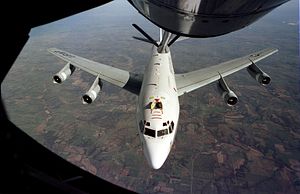On Wednesday, two Chinese People’s Liberation Army Air Force (PLAAF) Su-30 fighters intercepted a U.S. Air Force Boeing WC-135 Constant Phoenix aircraft over the East China Sea, according to U.S. authorities. U.S. officials are describing the intercept as “unprofessional.”
“While we are still investigating the incident, initial reports from the U.S. aircrew characterized the intercept as unprofessional. The issue is being addressed with China through appropriate diplomatic and military channels,” U.S. Air Force Lt. Col. Hodge said in a statement.
According to CNN’s report on the incident, “the Chinese jets came within 150 feet of the US plane, with one of the Su-30s flying inverted, or upside down, directly above the American plane.” The incident reportedly took place in international airspace. China has not released any statement.
The WC-135 Constant Phoenix aircraft detects radioactive debris and collects other atmospheric and weather-related data; at least one has been deployed in the Asia-Pacific in anticipation of a sixth North Korean nuclear test. Reports in April noted that the United States had deployed a WC-135 to Okinawa.
Wednesday’s incident is the first serious aerial encounter between the United States and China since an incident the United States described as unsafe near Scarborough Shoal in February 2017. In that incident, a Chinese Shaanxi KJ-200 airborne early warning & control (AEW&C) aircraft flew within 1,000 feet of a U.S. Navy Lockheed P-3C Orion.
Two similar incidents took place in 2016. In June 2016, over the East China Sea, where China declared an air defense identification zone in 2013, a U.S. Boeing RC-135 was intercepted by one PLAAF Chengdu J-10 fighter. The Chinese fighter flew within around 100 feet of the U.S. aircraft.
In May 2016, over the South China Sea, two PLAAF Shenyang J-11 fighters flew within 50 feet of a U.S. Navy EP-3 Aries signals reconnaissance aircraft. The United States described that incident as an unsafe intercept as well.
In 2015, an aerial encounter between the United States and China occurred when a U.S. RC-135 reconnaissance aircraft was intercepted 80 miles east of China’s Shandong province, in international airspace. Two Chinese JH-7 aircraft came within 500 feet of the U.S. aircraft in that incident.
Similarly, in August 2014, a PLAAF fighter made passes near a U.S. P-8 Poseidon surveillance aircraft that were described at the time as “unprofessional” and “dangerous.” In that incident, U.S. authorities said that the Chinese fighter passed near the P-8 “at 90 degrees with its belly towards the P-8 Poseidon … to make a point of showing its weapons load.”
In September 2015, during a state visit by Chinese President Xi Jinping to the United States, the U.S. and China concluded an agreement to govern air-to-air encounters of military aircraft. The agreement was meant to prevent unsafe incidents in the airspace near China.
In 2001, a Chinese F-8 fighter collided with a U.S. EP-3 aircraft near China’s Hainan Island, killing the Chinese pilot and grounding the U.S. plane. The incident spiraled into a major bilateral dispute between the two countries.
Update: This article has been updated to reflect corrected statements by U.S. officials that the incident took place in the East China Sea, not the Yellow Sea.

































